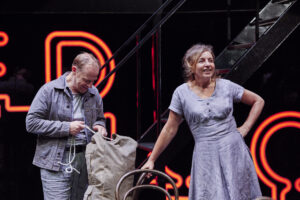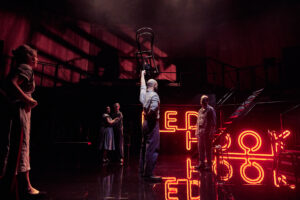Headlong’s version of Arthur Miller’s classic is well acted but over egged
★★★

A View from The Bridge is a modern classic. Rooted in ancient Greek tragedy, it was written by Arthur Miller, a man who has a claim to be the greatest playwright of the twentieth century.
When you produce a new version of a classic play, inevitably some of your audience will have memories of previous productions. In Britain, Alan Ayckbourn’s 1987 National Theatre production with the great Michael Gambon and Ivo Von Hove’s 2014 Young Vic production starring Mark Strong both loom large as benchmarks. They may be hard acts to follow, but theatre demands new productions. Of course, you can watch a film of the Young Vic production, but a stage play is designed to be a unique nightly collaboration between actors and us the audience.
So I looked forward to Headlong’s production, which has been co-produced with Chichester Festival Theatre, Octagon Theatre Bolton, and the Rose Theatre. Thanks to the accomplished well-directed cast, Headlong’s A View From The Bridge is worth seeing, but, in an over egged production, the director doesn’t allow the play to speak for itself.
Let’s start with a brief summary of the plot. Eddie Carbone is a longshoreman or dock worker in New York. He lives in an Italian American community, just below the Brooklyn Bridge. And Miller tells us that title refers to us- the middle class audience with our modern outlook- observing from the bridge this normally out-of-sight working class community rooted in a more ancient culture.
Eddie and his wife Beatrice have brought up her dead sister’s daughter Catherine who has now arrived at that moment when a child becomes an adult. (It’s around 1950, so we must accept that kids grew up more slowly in those days.) Eddie still sees her as the little girl he needs to protect but that feeling is now coloured by an unacknowledged sexual attraction.
Then two of Bea’s cousins arrive from Italy. The brothers are illegal immigrants, what we might call today economic migrants who have escaped the poverty, in Rodolpho’s case to become an American citizen, in Marco’s case to earn money to support his family.
Things start to go wrong when Catherine and Rodolpho fall in love. Eddie is jealous but hides this by implying that Rodolpho is really gay and is tricking Catherine into marrying him in order to gain US citizenship. Eddie’s inner conflict and how this inarticulate working class man deals with it is the core of the tragedy of this play.
The cast are uniformly excellent and Holly Race Roughan’s production gives them the space to savour the language of the play. Jonathan Slinger as Eddie brings out the frustration, ignorance and anger required in the role, as he swaggers, slumps, stares and rages.
Rachelle Diedericks as Catherine starts naïve, barely recognising her own sexual power. She matures until by the end of the play she is confident enough to shout down Eddie. It’s a subtle blossoming that marks Ms Diedericks as an actor to watch out for.
Eddie’s conduct is appalling and it’s hard to feel sympathy for him but he presents a challenge for Catherine and Beatrice, who both love him, and are in many ways the play’s ultimate victims.
Bea is possibly the most interesting character. She clearly envies Catherine and encourages her to take advantage of opportunities she never had. Kirsty Bushell imbues Bea with an inner strength and confidence which give her a power over Eddie, and for much of the play she is able to subdue his more extreme behaviour. She is frustrated by Eddie’s lack of sexual interest in her and her constant revealing of her legs can be taken as a sign of her own active sexuality.
Why is Eddie not interested in her? It is not simply that he is distracted by Catherine. The text hints that he may have, again uncoinscious, homosexual leanings, which adds another layer to this complex play. Maybe Eddie is even attracted to Rodolpho.
It’s possible that Arthur Miller would have developed this more, if he’d written the play today, but this production decides to do the job for him by featuring a fantasy male ballet dancer performing homoerotically in front of Eddie. I don’t know why Holly Race Roughan, who us s talented director, felt we needed this aspect of the play marked with a fluorescent pen. Just as earlier, when we first see Catherine, she is on a children’s swing, a prop that seems to clutter the stage and serve no purpose except to underline her adolescence. It’s as if the director doesn’t trust the text to make the point without underlining it.

As for Rodolpho, Luke Newberry plays him as artistic, sensitive and passionate, but without any obvious sign of him being gay. Like the modern American he aspires to be, Rodolpho sees the value in the virtues of compromise and forgiveness.
By contrast, his brother Marco, in a beautifully restrained performance by Tommy Sim’aan, is strong and silent except for the moment when he dramatically takes centre stage to show Eddie who is the alpha male.
The conflict between the rule of law and the code of the Italian community is another major theme. And Eddie’s self-inflicted downfall comes from his breach of the code, and his recourse to the law. This makes the part of the lawyer Alfieri pivotal in raising questions about the limits of the law in providing justice, particularly in a community which in the past has sorted out its own forms of justice. Nancy Crane takes on this role, possibly the first time a woman has played the part. She is authoritative and sympathetic, in a way appropriate to someone who is also a narrator-cum-Greek chorus, a role designed to remind us that we are outsiders viewing the unfolding tragedy.
The austere set by Moi Tran comprises a claustrophobic shiny black wall and stage, with an oppressive neon sign saying Red Hook, the name of the neighbourhood, that might have looked good in an art gallery but was over the top for this family drama. A staircase and high walkway are a further indication of how low this family are. The main props are a number of wooden chairs. It probably seemed like a good idea at the time to make the chairs double as the heavy bales the longshoremen carry, but it didn’t really work.
I regret I have one more criticism to make of the directing. During the final moving final tableau, a very large member of the cast stands at the front of the stage, blocking the view of a significant part of the audience. This is frankly unforgivable.
Having got that off my chest, let me say that, generally, Holly Race Roughan has put together a decent version of A View From The Bridge. It has light and shade, variations of pace, and dollops of tension. But, if the creative team had done less, they could have achieved more.
A View From The Bridge opened at Octagon Theatre Bolton on 8 September 2023. It can be seen at Chichester Festival Theatre until 28 October and at Rose Theatre from 31 October to 11 November 2023.
Paul was given a review ticket by the theatre.
Watch this review on the YouTube channel Theatre Reviews With Paul Seven